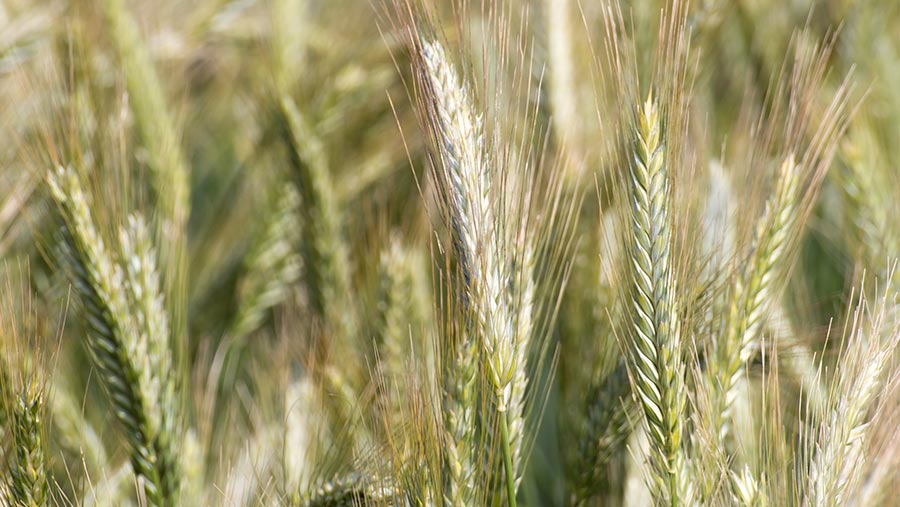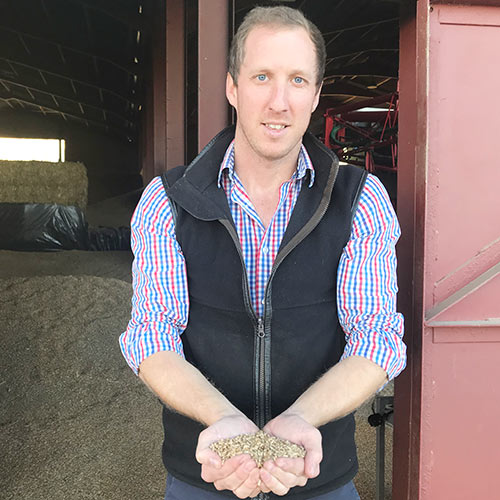Winter barley abandoned for triticale on Shropshire farm
 © Tim Scrivener
© Tim Scrivener A Shropshire grower is swapping to triticale this spring after a wet autumn prevented him from drilling more than half of his winter barley area.
With its tolerance to drought, triticale is usually grown on lighter soils, but Matthew Williams plans to make use of its long drilling window to try it on his heavier land in place of spring barley.
He hopes that with an expected abundance of spring barley this coming harvest likely to put pressure on prices, and a shortage of wheat likely to increase marketing opportunities for the unusual crop, that triticale will be a profitable choice.
See also: Why spring barley growers are switching to Diablo
Drought tolerance
Mr Williams grew triticale for the first time last season as an alternative to spring barley on his lightest sharp sand land.
Historically the land, which Mr Williams contract farms, had been rented out for potatoes during the rotation, but has more recently been used to grow spring barley.
However, he has not been able to make a profit from the crop due to the light land and several dry seasons.
During the very dry 2018 season the spring barley gave up in June, and produced no yield and hardly any straw, he says.
“I’ve got to make money, so I needed to change what we were doing,” says Mr Williams.
Triticale, with its great drought tolerance, became an obvious alternative despite not having previously taken off with growers.
“I went to Croptec in 2017 and got chatting to Cope Seeds. They were very keen to get crops into Shropshire because the crops here are relatively clean of blackgrass in comparison to Lincolnshire, where they are based.”
Cope Seeds suggested that Mr Williams grew triticale on a seed contract, netting him a premium over the base feed wheat price at the time of movement.
He also grew triticale for feed, which sells for a slightly lower price than wheat, but is cheaper to grow.
Despite feed variety Fido having the reputation of being a better performer, which is why Mr Williams also grew it, his seed variety Securo produced higher yields with no extra input costs.
On average the triticale yielded just over 7.5t/ha, with one field achieving more than 8t/ha.
“It also produced a phenomenal straw crop – the straw did over 5.5t/ha and here in the west there is such a market for straw,” he says.
Although he would like to not bale his straw and instead direct drill, his soils are not in the right condition, and with straw fetching £250/ha, he cannot afford not to sell it.
“That’s a good way of paying rent, I can’t save £250/ha on fertiliser by chopping straw,” says Mr Williams.

Matthew Williams
Finding a market
Although the crop produces a lot of straw, the main drawback with growing triticale is finding a market.
Mr Williams markets his feed crop through ADM, with local mills taking the wheat and rye hybrid.
“It’s a difficult crop to market if a farmer hasn’t had it before. We’ve had to sell it as a wheat hybrid straw, but once people are using it they are absolutely fine with it and have had more afterwards.”
Despite the marketing difficulties, Mr Williams is so impressed with the crop that he would like to grow it instead of second wheats in his rotation, to reduce the chance of take-all build-up.
However, the crop will first need to perform on his heavier land this season.
“I don’t know how many people have tried it on heavy land, it’s a bit of a stab in the dark,” he says.
With the crop set to be drilled on both light and heavy land, this spring he will have 138ha of triticale, which should give him around 1,000t to sell.
“That’s a considerable amount, but this year there will be a lot less wheat on the market so it shouldn’t be too hard to sell.
“People say they can’t use it as feed because it isn’t wheat, but it has a higher protein content.
“A local poultry farmer is keen for a sample, so this year might be the year that overcomes that hurdle.
Mr Williams will look to move it later in the selling campaign for the 2020 harvest, as if he can push it into a market that is short of wheat then it may even sell at the same price.
“I’m a glass-full kind of chap, there isn’t enough crop in the ground yet to pay the bills, but we are at average rainfall for the year now, so it should stop raining.”
If he can drill his wheat in January and it yield around 8t/ha, then at £160/t he can make money. “We are OK at the moment, but triticale might be the saviour for us this year.”
Guaranteed yield
Mr Williams grew triticale for the first time last year, drilling 42ha after oilseed rape.
The triticale was one of the last crops to go in, with everything on the farm drilled up in the week of 2 October.
The crop was drilled at 155kg/ha, but he may push this up to 165kg/ha, or even 170kg/ha when he drills this spring, as the feed crop could have been thicker.
The seed doesn’t require a dressing, which means he will be able to drill his remaining stored triticale straight from the shed.
The crop received a pre-emergence of Quirinus (flufenacet + picolinafen), another herbicide in March, and a T1 and T2 fungicide spray in the second week of April and the second week of May, respectively.
“My agronomist Bryce Rham went and did the recommendations for T1 and phoned me and said he didn’t like triticale, he said it was riddled with yellow rust and we had got to spray immediately.
“We sprayed, and two weeks later he phoned me again and said he loved it. The T1 had stopped the rust dead, and now he’s started suggesting triticale to his other clients,” says Mr Williams.
One of the main agronomical issues with triticale is keeping it up due to its rye genetics, so Mr Williams applied a growth regulator in March and another two in April.
Slugs were not an issue last season as the land was so light, but could potentially be more of a problem this season on the heavier land.
“The main thing is keeping it stood, and the fact that it gets yellow rust very easily, but that is not hard to knock out,” he says.
He also put two litres/ha of magnesium on the crop every time the sprayer went through to keep the leaf green.
At harvest time the feed variety Fido finished very quickly and could have been combined two weeks earlier than it was, with nothing being sprayed off.
“I was worried half would have been on the floor, but it didn’t seem to shed anything and it combined a treat.
“The only thing we did find was that we were limited on harvest capacity due to the quantity of straw going through the combine,” he says.
Fungicide and growth regulator programme
Fungicides
• T1 – Azoxystar (azoxystrobin) + Toledo (tebuconazole)
• T2 – Elatus Era (benzovindiflupyr + prothioconazole)
Plant growth regulators
• March – chlormequat
• T1 – chlormequat + Moddus (trinexapac-ethyl)
